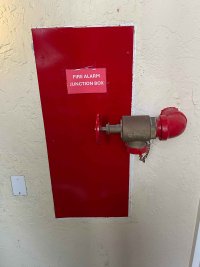-
Welcome to The Building Code Forum
Your premier resource for building code knowledge.
This forum remains free to the public thanks to the generous support of our Sawhorse Members and Corporate Sponsors. Their contributions help keep this community thriving and accessible.
Want enhanced access to expert discussions and exclusive features? Learn more about the benefits here.
Ready to upgrade? Log in and upgrade now.
You are using an out of date browser. It may not display this or other websites correctly.
You should upgrade or use an alternative browser.
You should upgrade or use an alternative browser.
Electrical - Is This A Violation of the NEC?
- Thread starter jar546
- Start date
wwhitney
REGISTERED
The only section I'm aware of that is definitely applicable is NEC 314.29. If you can remove the cover and access the wiring inside without having to modify that valve, that would comply with NEC 314.29.
There's also 110.26, which the configuration shown obviously doesn't comply with, but junction boxes generally don't have to comply with 110.26. I'm not familiar with fire alarm systems, so I suppose that junction box might contain something unusual that would trigger the 110.26 requirements.
Cheers, Wayne
There's also 110.26, which the configuration shown obviously doesn't comply with, but junction boxes generally don't have to comply with 110.26. I'm not familiar with fire alarm systems, so I suppose that junction box might contain something unusual that would trigger the 110.26 requirements.
Cheers, Wayne
jar546
CBO
Junction boxes must be accessible but not readily accessible. There is no violation of the NEC.
TheCommish
SAWHORSE
The stupid code comes into play, it is not allowed
jar546
CBO
But it is not - not allowed, therefore there is no violation.The stupid code comes into play, it is not allowed
wwhitney
REGISTERED
Unless that junction box contains some piece of equipment that is deemed to be subject to 110.26. The scope of section 110.26 is not super precise and the interpretation of when it applies is often a subject of disagreement, so it is certainly possible.Junction boxes must be accessible but not readily accessible. There is no violation of the NEC.
Cheers, Wayne
tmurray
SAWHORSE
Does the value block a screw on that side. It looks like it might.
jar546
CBO
What if there are low voltage wires and house voltage wires in the same box?Unless that junction box contains some piece of equipment that is deemed to be subject to 110.26. The scope of section 110.26 is not super precise and the interpretation of when it applies is often a subject of disagreement, so it is certainly possible.
Cheers, Wayne
jar546
CBO
It does not. You can easily reach it with a snubby screwdriver.Does the value block a screw on that side. It looks like it might.
Gregg Harris
SAWHORSE
Accessibility for Non-hazardous Locations: NEC 314.29
Section 314.29 specifies the requirements for junction boxes used in non-hazardous locations. Junction boxes should be accessible for inspection, maintenance and repair jobs. The location must allow for safe operation and maintenance and be free from any obstructions.Junction boxes must be securely supported to prevent them from coming loose or moving. In addition, they have to be supported by framing, clamps or other similar supports.
Box covers must be securely fastened to prevent accidental contact with live conductors. The covers should be closed with screws or something similar. They should press firmly against the surrounding surface and extend past the edge by

